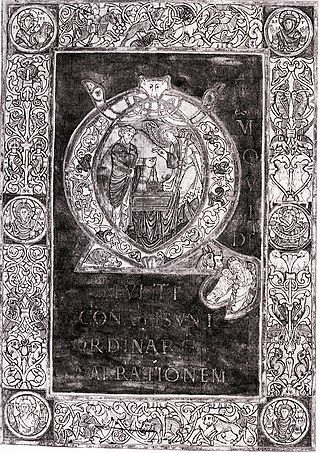
Columbanus was an Irish missionary notable for founding a number of monasteries after 590 in the Frankish and Lombard kingdoms, most notably Luxeuil Abbey in present-day France and Bobbio Abbey in present-day Italy.

Arnulf of Metz was a Frankish bishop of Metz and advisor to the Merovingian court of Austrasia. He later retired to the Abbey of Remiremont. In French he is also known as Arnoul or Arnoulf. In English he is known as Arnold.

Gall according to hagiographic tradition was a disciple and one of the traditional twelve companions of Columbanus on his mission from Ireland to the continent. However, he may have originally come from the border region between Lorraine and Alemannia and only met Columbanus at the monastery of Luxeuil in the Vosges. Gall is known as a representative of the Irish monastic tradition. The Abbey of Saint Gall in the city of Saint Gallen, Switzerland was built upon his original hermitage. Deicolus was the elder brother of Gall.

Luxeuil Abbey, the Abbaye Saint-Pierre et Saint-Paul, was one of the oldest and best-known monasteries in Franche-Comté, located in what is now the département of Haute-Saône in Franche-Comté, France.

Sep. 12 - Eastern Orthodox liturgical calendar - Sep. 14

A double monastery is a monastery combining separate communities of monks and of nuns, joined in one institution to share one church and other facilities. The practice is believed to have started in the East at the dawn of monasticism. It is considered more common in the monasticism of Eastern Christianity, where it is traceable to the 4th century. In the West the establishment of double monasteries became popular after Columbanus and sprang up in Gaul and in Anglo-Saxon England. Double monasteries were forbidden by the Second Council of Nicaea in 787, though it took many years for the decree to be enforced. Double monasteries were revived again after the 12th century in a significantly different way when a number of religious houses were established on this pattern among Benedictines and possibly the Dominicans. The 14th-century Bridgittines were purposely founded using this form of community.
Waldebert, , was a Frankish count of Guines, Ponthieu and Saint-Pol who became abbot of Luxeuil, and eventually a canonized saint in the Roman Catholic Church and Eastern Orthodox Church. Like several among his kinsmen, he protected the Church, enriched it with lands and founded monasteries. His brother was Saint Faro.
Saint Amatus, also called St. Aimé or Aimé of Sion, was a Benedictine monk.

Saint Amatus, also called Amatus of Grenoble or Saint Ame or Aimee, was a Frankish Colombanian monk and hermit. Together with St. Romaric, he founded Remiremont Abbey.

Bertin, also known as SaintBertin the Great, was the Frankish abbot of a monastery in Saint-Omer later named the Abbey of Saint Bertin after him. He is venerated as a saint by the Catholic and Orthodox Churches. The fame of Bertin's learning and sanctity was so great that in a short time more than 150 monks lived under his rule. Among them were St. Winnoc and his three companions who had come from Brittany to join Bertin's community and assist in the conversions. Nearly the whole Morini region was Christianized.

Affligem Abbey is a Benedictine abbey in the municipality of Affligem, Flemish Brabant, Belgium, 19 km (12 mi) to the north-west of Brussels. Dedicated in 1086, it was the most important monastery in the Duchy of Brabant and therefore often called Primaria Brabantiae.

Ellwangen Abbey was the earliest Benedictine monastery established in the Duchy of Swabia, at the present-day town of Ellwangen an der Jagst, Baden-Württemberg, about 100 km (60 mi) north-east of Stuttgart.

Wettingen-Mehrerau Abbey is a Cistercian territorial abbey and cathedral located at Mehrerau on the outskirts of Bregenz in Vorarlberg, Austria. Wettingen-Mehrerau Abbey is directly subordinate to the Holy See and thus forms no part of the Catholic Archdiocese of Salzburg. The abbot of Wettingen-Mehrerau, however, is a member of the Austrian Bishops' Conference. The official name of the abbey is Beatae Mariae Virginis de Maris Stella et de Augia Majore.

Bobbio Abbey is a monastery founded by Irish Saint Columbanus in 614, around which later grew up the town of Bobbio, in the province of Piacenza, Emilia-Romagna, Italy. It is dedicated to Saint Columbanus. It was famous as a centre of resistance to Arianism and as one of the greatest libraries in the Middle Ages. The abbey was dissolved under the French administration in 1803, although many of the buildings remain in other uses.

The Abbey of Saint Maurice, Agaunum is a Swiss monastery of canons regular in Saint-Maurice, Canton of Valais, which dates from the 6th century. It is situated against a cliff in a section of the road between Geneva and the Simplon Pass. The abbey itself is a territorial abbacy and not part of any diocese. It is best known for its connection to the martyrdom of the Theban Legion, its original practice of perpetual psalmody, and a collection of art and antiquity.

Saint Germanus of Granfelden was the first abbot of Moutier-Grandval Abbey. He is venerated as a martyr saint in the Catholic and Eastern Orthodox Churches.
Eustace of Luxeuil, also known as Eustasius, was the second abbot of Luxeuil from 611. He succeeded his teacher Columbanus, to whom he had been a favorite disciple and monk. He had been the head of the monastic school.

Remiremont Abbey was an abbey that was founded as a house of nuns near Remiremont, Vosges, France. It later became a community of secular canonesses.

Maurontius of Douai was a nobleman and Benedictine abbot. His parents were Rictrude and Adalbard. He is a Catholic saint, with a feast day on May 5, especially venerated in Douai, France. His sisters Clotsinda, Adalsinda and Eusebia of Douai are also saints.
Saint Agilus was a Frankish nobleman who became a Christian missionary in Bavaria and later was abbot of Rebais monastery near Paris, France. He was considered a saint, and his feast day is 30 August.
















